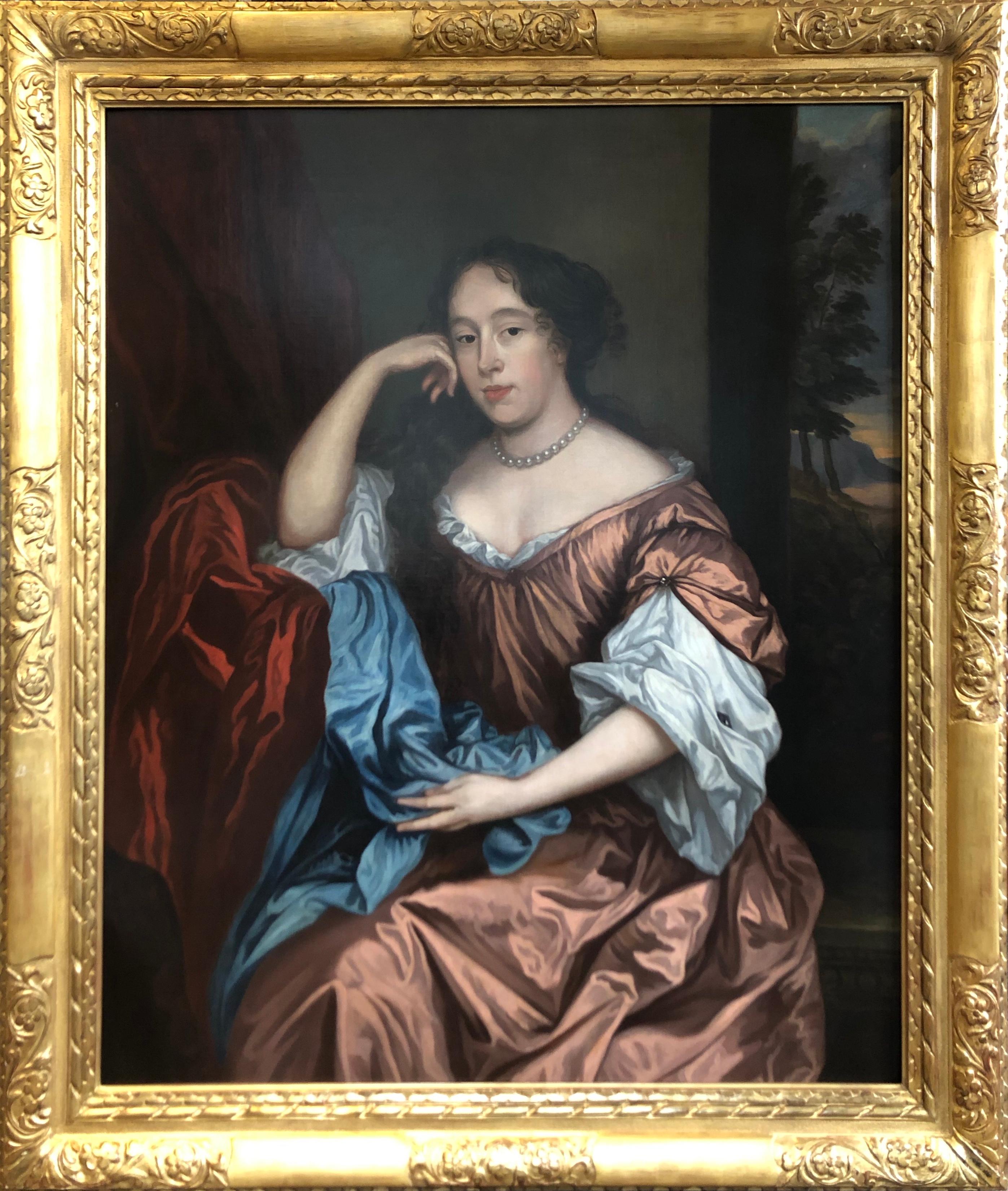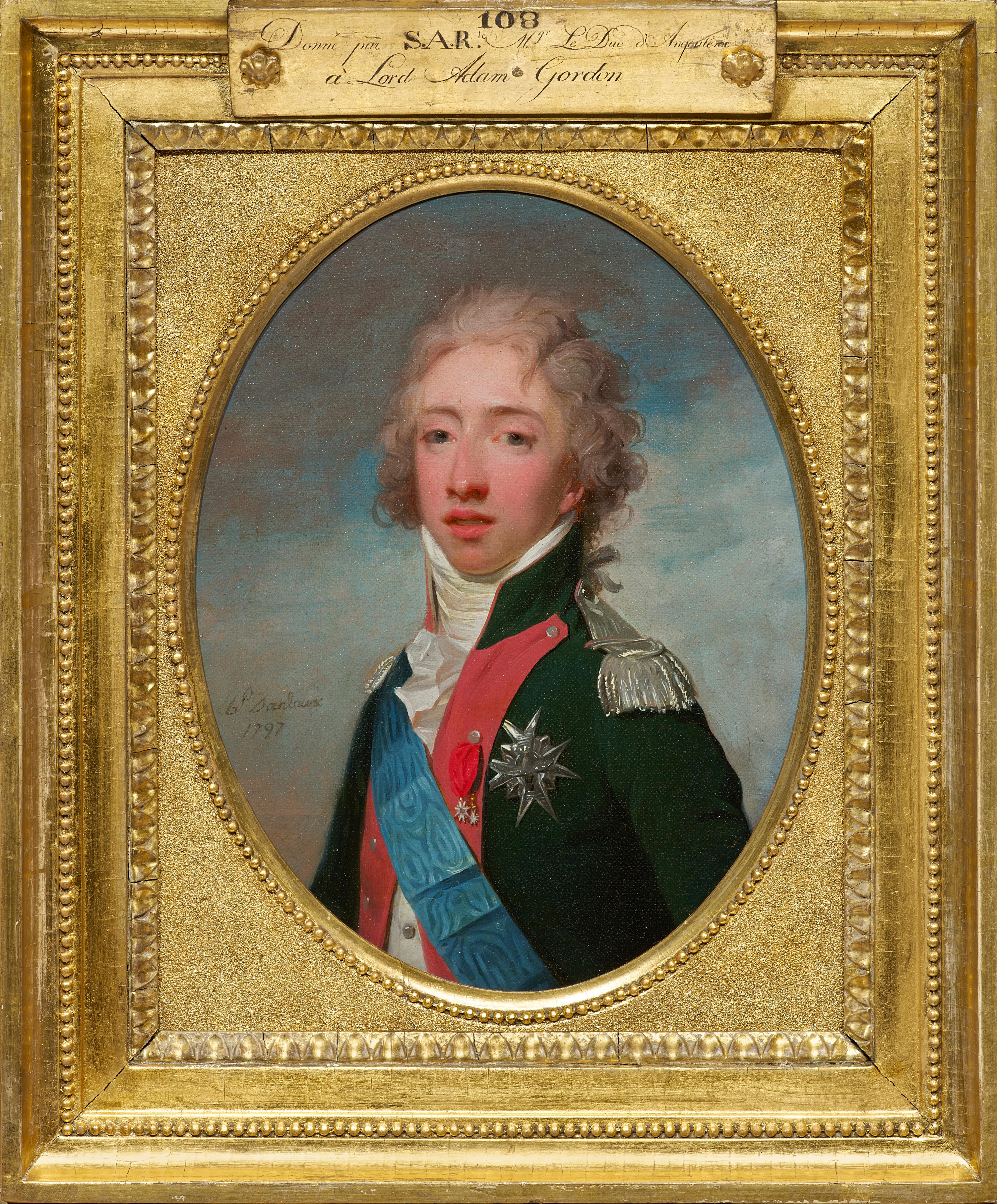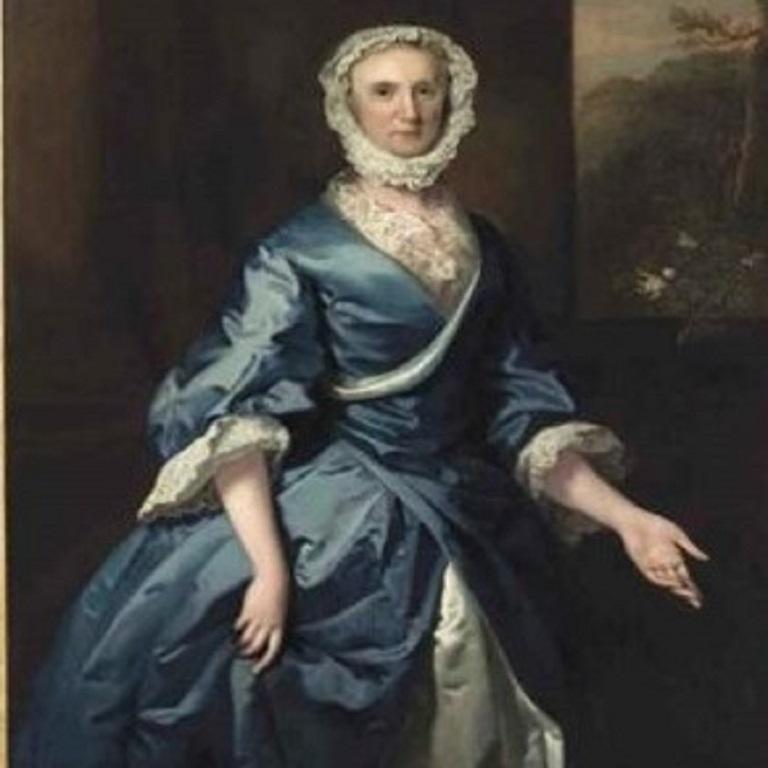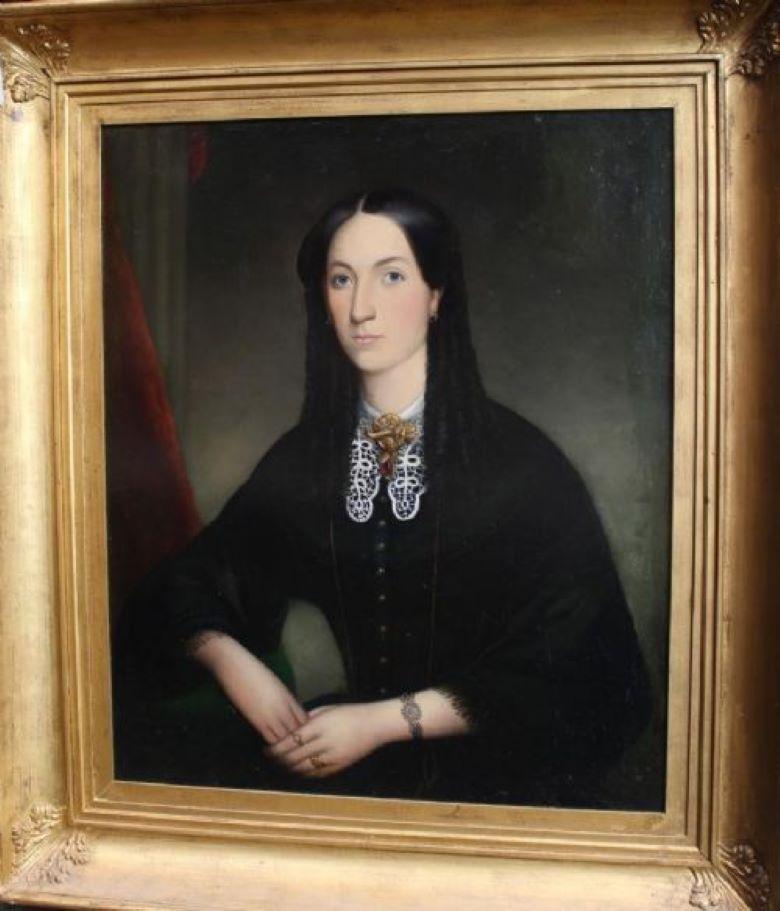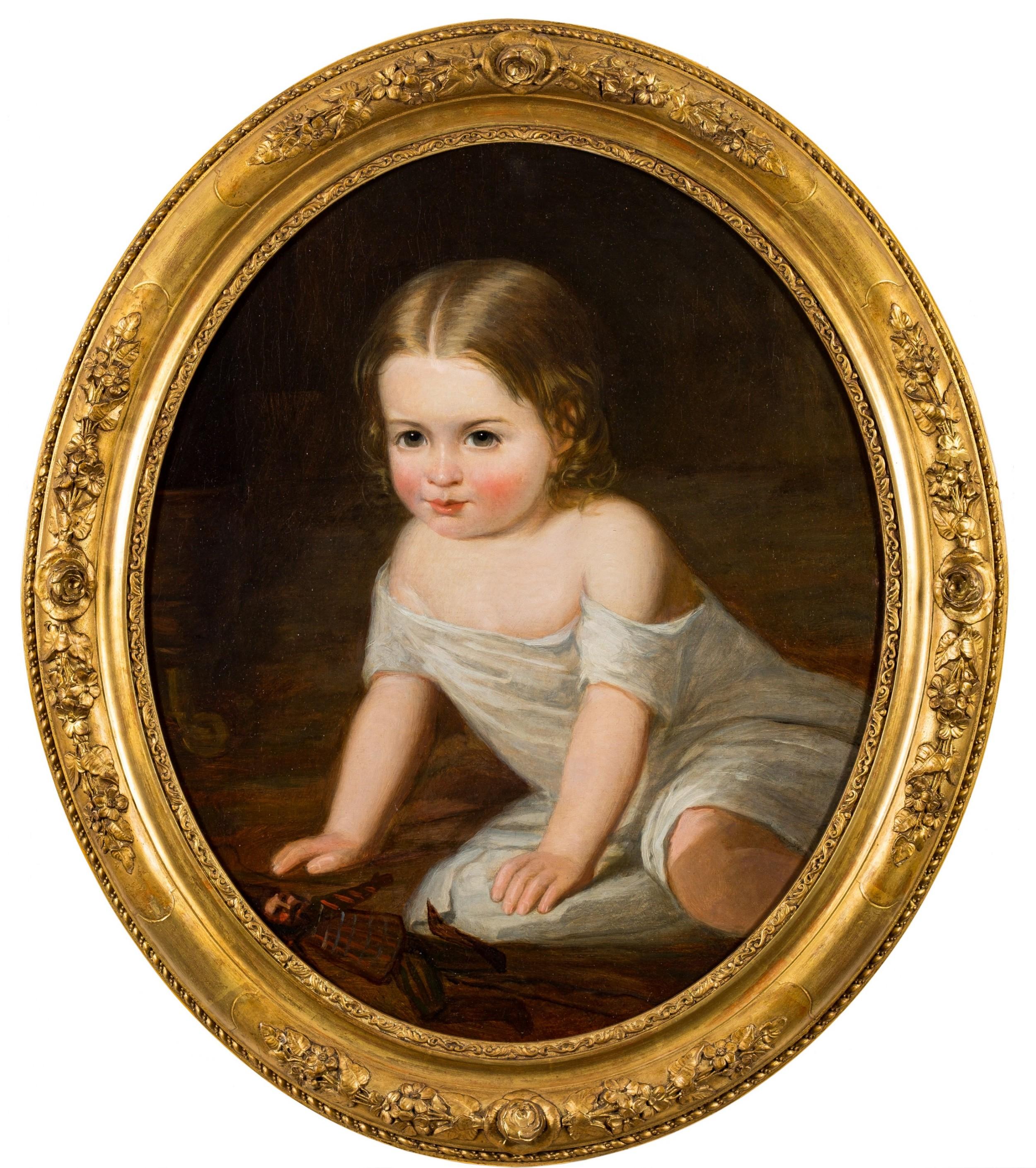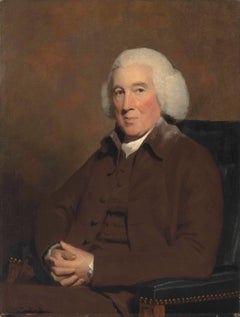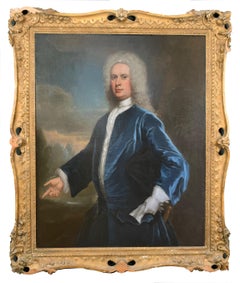
2nd Marquess of Bath
View Similar Items
Want more images or videos?
Request additional images or videos from the seller
1 of 11
Charles Philips2nd Marquess of Bathcirca 1740
circa 1740
About the Item
- Creator:Charles Philips (1707 - 1742, American)
- Creation Year:circa 1740
- Dimensions:Height: 27 in (68.58 cm)Width: 25.75 in (65.41 cm)
- More Editions & Sizes:UniquePrice: $10,080
- Medium:
- Movement & Style:
- Period:
- Condition:
- Gallery Location:London, GB
- Reference Number:1stDibs: LU67332361123
About the Seller
5.0
Vetted Seller
These experienced sellers undergo a comprehensive evaluation by our team of in-house experts.
Established in 1990
1stDibs seller since 2017
40 sales on 1stDibs
More From This SellerView All
- 18th Century Oil Painting Portrait of Provost John Pitcairn of DundeeBy Sir Henry RaeburnLocated in London, GBThe pendant to the present portrait showing John Pitcairn's wife Jean, née Robertson, is in the Huntington Art Gallery, San Marino. Both works are datable to the 1790s. Pitcairn, who served as Provost of Dundee from 1782-84, a position his father-in-law also held from 1731-32, later sat to Raeburn for another portrait, dated to circa 1820, which is now in the Royal Scottish Academy, Edinburgh Sale of Christie's London: Wednesday, July 9, 2014 [Lot 00212] Old Master & British Paintings Day Sale Sold For 22,500 GBP Premium Provenance By descent from the sitter to his great-grandson, Ronald Andrew Pitcairn of Pitcullo; Christie's, London, 25 June 1904, lot 58 (200 gns. to Wallis). Alexander Reid, Glasgow. With Agnew's, London, where acquired by A.R. Wilson Wood, 7 April 1909; Christie's, London, 26 June 1914, lot 78 (850 gns. to Agnew). Anonymous sale; Christie's, London, 24 November 1972, lot 27 (320 gns.) Private collection, Dublin, Ireland Exhibition Edinburgh, Royal Scottish Academy, 1876, no. 256 Literature W. Armstrong, Sir Henry Raeburn, London, 1901, p. 110. J. Greig, Sir Henry Raeburn, R.A., His life and work with a catalogue of his pictures, London, 1911, p. 55. R. Asleson and S.M. Bennett, British Paintings at The Huntington, New Haven and London, 2001, p. 312, fig. 12 Sir Henry Raeburn FRSE RA RSA (4 March 1756 – 8 July 1823) was a Scottish portrait painter and Scotland's first significant portrait painter since the Union to remain based in Scotland. He served as Portrait Painter to King George IV in Scotland. Raeburn was born the son of a manufacturer in Stockbridge, on the Water of Leith: a former village now within the city of Edinburgh. He had an older brother, born in 1744, called William Raeburn. His ancestors were believed to have been soldiers, and may have taken the name "Raeburn" from a hill farm in Annandale, held by Sir Walter Scott's family. Orphaned, he was supported by William and placed in Heriot's Hospital, where he received an education. At the age of fifteen he was apprenticed to the goldsmith James Gilliland of Edinburgh, and various pieces of jewellery, mourning rings and the like, adorned with minute drawings on ivory by his hand, still exist. Soon he took to the production of carefully finished portrait miniatures; meeting with success and patronage, he extended his practice to oil painting, at which he was self-taught. Gilliland watched the progress of his pupil with interest, and introduced him to David Martin, who had been the favourite assistant of Allan Ramsay the Latter, and was now the leading portrait painter in Edinburgh. Raeburn was especially aided by the loan of portraits to copy. Soon he had gained sufficient skill to make him decide to devote himself exclusively to painting. George Chalmers (1776; Dunfermline Town Hall) is his earliest known portrait. In his early twenties, Raeburn was asked to paint the portrait of a young lady he had noticed when he was sketching from nature in the fields. Ann was the daughter of Peter Edgar of Bridgelands, and widow of Count James Leslie of Deanhaugh. Fascinated by the handsome and intellectual young artist, she became his wife within a month, bringing him an ample fortune. The acquisition of wealth did not affect his enthusiasm or his industry, but spurred him on to acquire a thorough knowledge of his craft. It was usual for artists to visit Italy, and Raeburn set off with his wife. In London he was kindly received by Sir Joshua Reynolds, the president of the Royal Academy, who advised him on what to study in Rome, especially recommending the works of Michelangelo, and gave Raeburn letters of introduction for Italy. In Rome he met his fellow Scot Gavin Hamilton, Pompeo Girolamo Batoni and Byers, an antique dealer whose advice proved particularly useful, especially the recommendation that "he should never copy an object from memory, but, from the principal figure to the minutest accessory, have it placed before him." After two years of study in Italy he returned to Edinburgh in 1787, and began a successful career as a portrait painter. In that year he executed a seated portrait of the second Lord President Dundas. Examples of his earlier portraiture include a bust of Mrs Johnstone of Baldovie and a three-quarter-length of Dr James Hutton...Category
18th Century Old Masters Figurative Paintings
MaterialsOil
- 17th Century Oil Painting Portrait of a Young English BoyBy Gerard SoestLocated in London, GBGerard SOEST (1600 - 1681) Portrait of a Young Boy oil on canvas 35.5 x 30.5 inches inc. frame Gerard Soest (circa 1600 – 11 February 1681), also known as Gerald Soest, was a portra...Category
17th Century Old Masters Portrait Paintings
MaterialsOil
- 18th Century Oil Painting Portrait of Phillip, 6th Viscount Wenman.By Nathaniel Dance-HollandLocated in London, GBSir Nathaniel Dance-Holland (1750-1811) was an English portrait painter and one of the founding members of the Royal Academy in 1768. Justly celebrated in his lifetime he won several...Category
Late 18th Century Old Masters Portrait Paintings
MaterialsOil
- C19th Portrait Princesse de Joinville of Brazil - Spectacular fit for a palaceBy Henri d'Ainecy MontpezatLocated in London, GBPortrait of Princess de Joinville riding a Bay Horse Henri d’Aincy, Le Comte Monpezat (French 1817-1859) Painted circa 1837-9 oil on canvas 113 x 92 inches (including frame) 92 x 70 inches (unframed) Provenance – from a private royal collection This magnificent portrait depicts Princess de Joinville, the daughter of Pedro I, Emperor of Brazil and the King of Portugal. Through her illustrious family she was directly related Alexander III and Nicholas II of Russia and the Russian royal family, as well as to many of the great ruling families of Europe. The work clearly confirms Monpezat as one of the most accomplished equestrian portrait painters in France in the early nineteenth century. In terms of scale, quality and dramatic power, it must surely be considered amongst his finest works. The stance of the powerful thoroughbred - in half rear - emphasises the calm nature and courage of the Princess. Francisca of Brazil (1824-98) married a son of Louis Philippe I, the King of the French, and had three children. Born at the Imperial Palace of Saint Christopher, her youngest brother was the future Pedro II...Category
1830s Old Masters Portrait Paintings
MaterialsOil
- 18th C. Portrait of the 4th Earl of Sandwich a View of Constantinople BeyondLocated in London, GBJohn Montagu, 4th Earl of Sandwich (13 November 1718 – 30 April 1792) Attributed to George Knapton (1698-1778) Dressed in the Turkish manner, stand...Category
18th Century Old Masters Figurative Paintings
MaterialsOil
- Lady Dormore - A 16th Century Portrait of a key member of Shakespeare's EnglandLocated in London, GBLady Dormer, Mary Browne c. 1592 oil on panel 35 x 29 inches, unframed; 41 x 34.75 inches, inc. frame Inscribed 'Lady Dormore' Mary married Henry Wriothesley, 2nd Earl of Southampton who gave birth to Henry Wriothesley, 3rd Earl of Southampton - one of the great figures in Shakespears"s circle and founder of the Virginia company, developers of Virginia USA. Henry Wriothesley, born 6 October 1573 at Cowdray House, Sussex, was the only son of Henry Wriothesley, 2nd Earl of Southampton, by Mary Browne, the only daughter of Anthony Browne, 1st Viscount Montague, and his first wife, Jane Radcliffe.[5] He had two sisters, Jane, who died before 1573, and Mary (c. 1567 – 1607), who in June 1585 married Thomas Arundell, 1st Baron Arundell of Wardour.[6] After his father's death, Southampton's mother married firstly, on 2 May 1595, as his second wife, Sir Thomas Heneage (d. 17 October 1595), Vice-Chamberlain of the Household, and secondly, between 5 November 1598 and 31 January 1599, Sir William Hervey. She died in November 1607.[7] Early life When his father died on 4 October 1581 Southampton inherited the earldom and landed income valued at £1097 6s per annum. His wardship and marriage were sold by the Queen to her kinsman, Charles, Lord Howard of Effingham, for £1000. According to Akrigg, Howard then "entered into some further agreement, of which no documentation can now be found, which transferred to Lord Burghley personally the custody and marriage of the young Earl, but left Howard holding his lands", and late in 1581 or early in 1582 Southampton, then eight years of age, came to live at Cecil House in the Strand.[8] In October 1585, at age twelve, Southampton entered St John's College, Cambridge,[9] graduating M.A. on 6 June 1589.[10] His name was entered at the Gray's Inn legal society before he left the university, and he was admitted on 29 February 1588.[11] On Southampton's 16th birthday, 6 October 1589, Lord Burghley noted Southampton's age in his diary, and by 1590 Burghley was negotiating with Southampton's grandfather, Anthony Browne, 1st Viscount Montague, and Southampton's mother, Mary, for a marriage between Southampton and Lord Burghley's eldest granddaughter, Elizabeth Vere, daughter of Burghley's daughter, Anne Cecil, and Edward de Vere...Category
16th Century Old Masters Figurative Paintings
MaterialsOil
You May Also Like
- Portrait of a Lady, After Sir Peter Lely (1610-1680) Oil PaintingBy After Sir Peter LelyLocated in Uppingham, GBOil Painting After Sir Peter Lely (1610-1680) Portrait of a Lady Housed in a Lely gold Leaf Frame. Peter Lely: In 1647 he became a member of the Pain...Category
17th Century Old Masters Portrait Paintings
MaterialsOil
- Oil Painting Portrait, attributed to John Vanderbank (1694-1739)By John VanderbankLocated in Uppingham, GBOil Painting Portrait of John Campbell, 4th Duke of Argyll,, att to John Vanderbank (1694-1739) Housed in a swept frame which has been restored after photo. Canvas Size 50" x 40", Fr...Category
1690s Old Masters Portrait Paintings
MaterialsCanvas, Oil
- 19th century portrait painted in St Petersburg in 1819Located in London, GBSigned, inscribed and dated, lower right: 'Geo Dawe RA St Petersburgh 1819', also signed with initials, lower centre: 'G D RA'; and signed and inscribed verso: 'Geo Dawe RA Pinxit 1819 St Petersburgh'; Also inscribed on the stretcher by Cornelius Varley with varnishing instructions. Collections: Private collection, UK, 2010 Literature: Galina Andreeva Geniuses of War, Weal and Beauty: George Dawe...Category
19th Century Old Masters Portrait Paintings
MaterialsCanvas, Oil
- Portrait of Jean-Baptiste Greuze, painted on linen by his daughter Anna GreuzeLocated in PARIS, FRThis replica of the last self-portrait of Jean-Baptiste Greuze painted in 1804, executed by his daughter Anna at her father's side and recently rediscovered, provides us with a poignant image of the great artist, represented with panache despite the disillusions of life. 1. Jean-Baptiste Greuze Jean-Baptiste Greuze was the sixth child of a roofer from Tournus and retained a certain rusticity in his behaviour from his provincial childhood, beyond his taste for describing picturesque scenes of the countryside. He initially started training with a little-known painter from Lyon, Charles Grandon, before his genius was recognised in Paris where he became a full-time student of the Académie (of Painting) in 1755. He exhibited his work for the first time at the Salon during the summer of 1755, before leaving on a trip to Italy in the company of Louis Gougenot, abbot of Chezal-Benoît. Upon his return to Paris, Greuze became a prolific painter, participating widely in the Salons held between 1759 and 1765, to which he sent no less than 63 paintings: numerous genre scenes (The Marriage Contract, The Beloved Mother), but also portraits of his family circle, of courtiers and art lovers, or of his colleagues. The Academy closed the doors of the Salons to him in 1767 for not having produced his reception piece within six months of his reception, as was the tradition. He worked actively on this painting (Emperor Severus rebukes Caracalla, his son, for trying to assassinate him ) until the summer of 1769, tackling historical and mythological subjects for the first time. Once this was completed, he was then fully admitted to the Academy, but as a genre painter, and not as an historical painter, which had been one of the greatest humiliations of his life. Greuze then refused any participation in events organised by the Academy or its successor, the Academy of Fine Arts until 1800. Abandoning history painting, he gave a new twist to genre scenes, bringing them closer to history painting, as in this pair of canvases which constitutes some of his masterpieces: The Paternal Curse: The Ungrateful Son and The Paternal Curse: The Punished Son . Married in 1759 to Anne-Gabrielle Babuti, the daughter of a Parisian bookseller, his marriage was unhappy and his wife probably frequently unfaithful. The institution of divorce enabled him to record their separation in 1793, keeping his two daughters Anna-Geneviève, born in April 1762, and Louise-Gabrielle, born in May 1764, with him. Little is known about his daughter Anna except that she was herself a painter and lived with her father until his death. It is likely that most of the paintings she produced up to that date were attributed to her father, whose technique she shared to a great extent, making it extremely difficult to establish an autonomous corpus of her paintings. Greuze died in his studio at the Louvre on March 21st 1805. The attention paid to the expressivity of his characters and the emotional charge they convey enabled Jean-Baptiste Greuze to enjoy immense popularity with the eighteenth-century public, and they still constitute Greuze's true modernity. As the artist said, "I dipped my brush in my heart". Greuze was also an exceptional draughtsman and a portraitist of immense talent and exceptional longevity who painted both the Dauphin (the son of Louis XV and father to Louis XVI) and the young Napoleon Bonaparte. 2. Greuze's self-portraits Greuze was very much influenced by Dutch paintings during all his life. While the source of his inspiration for genre scenes can be found in Gerard Dou...Category
Early 1800s Old Masters Portrait Paintings
MaterialsLinen, Oil
- Two royal portraits (the Duc d'Angoulême and the Duc de Berry) by H.P. DanlouxLocated in PARIS, FRThese two royal portraits are a major historical testimony to the stay of the Comte d'Artois (the future Charles X) and his family in Edinburgh in 1796-1797. Given by the sitters to Lord Adam Gordon, the Governor of Edinburgh, and kept by family descent to this day, these two portraits provide us with a vivid and spontaneous image of the Duc d’Angoulême and his brother the Duc de Berry. Danloux, who had emigrated to London a few years before, demonstrate his full assimilation of the art of British portrait painters in the brilliant execution of these portraits. 1. Henri-Pierre Danloux, a portraitist in the revolutionary turmoil Born in Paris in 1753, Henri-Pierre Danloux was first a pupil of the painter Nicolas-Bernard Lépicié (1735 - 1784) and then, in 1773, of Joseph-Marie Vien (1716 - 1809), whom he followed to Rome when, at the end of 1775, Vien became Director of the Académie de France. In Rome he became friends with the painter Jacques-Louis David (1748 - 1825). Returning to France around 1782, he settled in Lyon for a few years before returning to Paris in 1785. One of his first portraits was commissioned by the Baroness d'Etigny, the widow of the former Intendant of the Provinces of Gascony, Bearn and Navarre Antoine Mégret d'Etigny (1719 – 1767). He then became close to his two sons, Mégret de Sérilly and Mégret d'Etigny, who in turn became his patrons. In 1787, this close relationship with the d'Etigny family was further strengthened by his marriage to Antoinette de Saint-Redan, a relative of Madame d'Etigny. After his marriage, he left for Rome and did not return to France until 1789. It was during the winter of 1790-1791 that he painted one of his masterpieces, the portrait of Baron de Besenval. Set in a twilight atmosphere, this portrait of an aristocrat who knows that his death is imminent symbolizes the disappearance of an erudite and refined society which would be swept away by the French Revolution. The Jacobin excesses led Danloux to emigrate to England in 1792; many members of his family-in-law who remained in France were guillotined on 10 May 1794. Danloux enjoyed great success as a portrait painter in England before returning to France in 1801. During his stay in England, Danloux was deeply under the influence of English portraitists: his colors became warmer (as shown by the portrait of the Duc d'Angoulême that we are presenting), and his execution broader. 2. Description of the two portraits and biographical details of the sitters The Duc d'Angoulême (1775-1844) was the eldest son of the Comte d'Artois, the younger brother of King Louis XVI (the future King Charles X), and his wife Marie-Thérèse of Savoie. He is shown here, in the freshness of his youth, wearing the uniform of colonel-general of the "Angoulême-Dragons" regiment. He is wearing the blue cordon of the Order of the Holy Spirit, which was awarded to him in 1787, and two decorations: the Cross of Saint-Louis and the Maltese Cross, as he was also Grand Prior of the Order of Malta. Born on 16 August 1775 in Versailles, Louis-Antoine d'Artois followed his parents into emigration on 16 July 1789. In 1792, he joined the émigrés’ army led by the Prince de Condé. After his stay in Edinburgh (which will be further discussed), he went to the court of the future King Louis XVIII, who was in exile at the time, and in 1799 married his first cousin Marie-Thérèse Charlotte of France, the daughter of Louis XVI and the sole survivor of the royal family. The couple had no descendants. He became Dauphin of France in 1824, upon the accession to the throne of his father but played only a minor political role, preferring his military position as Grand Admiral. Enlisted in Spain on the side of Ferdinand VII, he returned home crowned with glory after his victory at Trocadero in 1823. He reigned for a very short time at the abdication of Charles X in 1830, before relinquishing his rights in favor of his nephew Henri d'Artois, the Duc de Bordeaux. He then followed his father into exile and died on 3 June 1844 in Gorizia (now in Italy). His younger brother, the Duc de Berry, is shown in the uniform of the noble cavalry of the émigrés’ Army. He is wearing the blue cordon of the Order of the Holy Spirit, awarded to him in May 1789, and the Cross of Saint-Louis (partly hidden by his blue cordon). Born on 24 January 1778 in Versailles, Charles-Ferdinand d'Artois also followed his parents into emigration and joined the émigrés’ army in 1792. After his stay in Edinburgh, he remained in Great Britain, where he had an affair with Amy Brown...Category
1790s Old Masters Portrait Paintings
MaterialsCanvas, Oil, Wood Panel
- Portrait of Julien Prieur as a hunter - Circle of Jean-Baptiste Oudry 1686-1755By Jean-Baptiste OudryLocated in PARIS, FRThis portrait depicts us the trusted confidant of the Conflans d'Armentières family. More precisely, Julien Prieur was the fiscal procurator of the Marquisate of Armentières, playing the role of representative of the "public ministry", safeguarding the interests of his lord. His role, one can imagine, was crucial at the death of Michel de Conflans (in 1717) since the latter left an heir, Louis, aged only 6, and a widow, Diane Gabrielle de Jussac, whom some memoirs describe as "a very clever grande dame" . Prieur ensured the smooth running of the family's affairs and it is probably to thank him for his services that Diane Gabrielle had his portrait painted, most probably by a painter close to Jean-Baptiste Oudry. Julien Prieur appears as he is, middle-aged, with a benevolent look, in his hunting suit. Only his knotted wig links him to the nobility. Above all, he is depicted as a hunter, a passion that he shared with the Marquis of Armentières. His very young master, Louis, became a first-rate hunter, hunting in the King's entourage, in whose cabinet he died of apoplexy in January 1774. As for the his son, he was one of Louis XVI's closest hunting companions, as numerous souvenirs attest . 1. Some biographical information about the model and the commissioner While the identity of many 18th century portraits is uncertain, an old label stuck on the reverse of the canvas gives us some precise information on the identity of the model: "Mr. Julien Prieur, homme d’affaires de Mr. le Marquis d'Armentières - Commune of Brécy - Aisne". The label also suggests that it could be his son Louis Prieur living in Rocourt (probably Rocourt-Saint-Martin, a neighbouring municipality of Brécy), born on 30 September 1745, who died on 8 July 1826, but this hypothesis must be rejected in view of the model's clothing. This label probably gives us an indication on the previous owner the owner of this painting; we will see later why it seems likely that this label was affixed between 1826 and 1832. Brécy is now a municipality in the Aisne County (Hauts-de-France) located between Soissons and Château-Thierry, slightly north of the Paris-Reims axis. It borders the municipalities of Armentières-sur-Ourcq and Rocourt-Saint-Martin. According to Louis Prieur's death certificate, he was in fact born in 1743 and not in 1745 . The age of the model in the painting and the dating of this painting would indicate that Julien Prieur, was probably born at the very end of the 17th century. In Louise-Marthe de Conflans-Coigny, chatelaine de Brécy , we read that "the Conflans were a family of ancient nobility, which genealogists trace back to the 12th century, when it was said to have come from the house of Brienne. In the 16th and 17th centuries, this family had several illustrations in the profession of arms. [...] Michel de Conflans, [...] belonged to a younger branch of the family, of which Saint-Simon wrote, with his acid soaked pen, that "poor and obscure, they had never left their village, where their house resembled a hut" and elsewhere that they "lived on their rifles and cabbages". Fortunately for Michel de Conflans, the last representative of the elder branch, Henriette d'Armentières, made him her heir on her death in 1712. It was through her that the land of Armentières and its 14th century castle became part of the estate of this branch, as well as, not far from there, the land of Brécy and the castle of Le Buisson, where the family lived. In the early years of the 18th century, Michel de Conflans was able to push himself into the entourage of the Duke of Orleans, becoming his first gentleman of the chamber. However it was above all his son Louis who restored the family status through his military career. Born on 23 February 1711, Louis de Conflans, Marquis d'Armentières died of apoplexy on 18 January 1774, in the King's cabinet at Versailles. Appointed lieutenant general in 1746, he received his Marshal of France’s stick in 1768. The Dictionary of French Biography writes of him that "without ever achieving a high command, he appeared with honour in all the wars of his time". The estates of Armentières and Le Buisson were sequestered during the French Revolution, declared national property and sold at auction (in 1794 and 1795 respectively) after the Marquise d'Armentières, the Marshal's second wife, was beheaded in 1794. The Château du Buisson (where Michel de Conflans died in 1717) was bought by a granddaughter of the Marshal de Conflans, the Marquise de Coigny, in 1816 and remained in her family after her death in 1832 until the sale of the 1,054 hectares estate in 1866. The bayonet blows that probably pierced the canvas in three places may well have a revolutionary origin and it is conceivable that the painting, acquired by the Marquise de Coigny from Louis Prieur, Julien's son, after the latter's death, was then restored and given the label specifying the name of the model. 2. Description of the portrait The painting presents a man in his thirties in his hunting costume. Pictured at mid-body, his face is marked by his life in the open air and characterised by a look of great bonhomie. Holding a rifle under his elbow, he is soberly dressed in a large caramel-coloured jacket, decorated with silver buttons. Presented in a three-quarter view, the model holds a partridge in his right hand. The jacket opens onto a vermilion waistcoat. A green shoulder strap probably holds a powder flask hidden under his arm while a satchel is visible on his belt. The model is wearing a grey wig, tied at the back with a black ribbon that seems to fly in the wind. This ornament anchors Julien Prieur in his time. "The new King of France, Louis XV, [imposed] a style of smaller wigs for men and the rigorous white or preferably greyish powdering. From the middle of the century men also used a ponytail on the back of the neck, tied with a ribbon, a style that became very popular in all courts." He stands out against a dark, purplish sky at the end of an autumn day in a soberly sketched forest landscape. The treatment of the sky recalls the influence of Largillière, Oudry's first master. 3. Jean-Baptiste Oudry Jean-Baptiste Oudry was born on 17 March 1686 in Paris, rue de la Ferronnerie. He began his apprenticeship around 1705-1707 with Nicolas de Largillière, with whom he stayed for five years. In 1713 Oudry established his "livre de raison" in which he reproduced all his early works in wash drawings up until 1718. During this first period which lasted about 7 years, Oudry produced works of great diversity, both in the genres that the artist tackled and in the artists which influenced him. It has been estimated that he painted about 150 pictures during this period: mainly portraits, but also still lifes and some religious paintings and landscapes. Of the hundred or so portraits that Oudry is said to have painted during this period, only fifteen have been identified today. A number of those lost portraits are probably still confused with works by Largillière. First admitted to the Académie de Saint-Luc in 1708, he was then allowed to join the Académie Royale in 1717, and subsequently admitted as a history painter in 1719. This year marks a turning point from which Oudry will assert himself as an animal painter. In 1723 he met Louis Fagon, Intendant of Finances, and the Marquis de Beringhen, the King's first equerry, who became both friends and patrons of the artist, giving him access to royal commissions and enabling him to be appointed as painter of the Royal Tapestry Factory of Beauvais in 1726. From 1728 onwards, the creation of tapestries became the core of his work, even though at the same time Oudry developed his skill as an illustrator, first for Scarron's Roman Comique and then for La Fontaine’s Fables. Between 1726 and 1731, Oudry created the decoration of a large drawing room at the château de Condé-en-Brie, about twenty kilometres from Brécy, which has remained in place to this day. This important commission, about which few details are known, is said to have originated with the Countess de Verrüe, a great lady of the French Regency who often stayed at Condé with her friend Jean-François Leriget, Marquis de la Faye, then owner of Condé. A prolific artist, Oudry fulfilled numerous commissions in parallel with his regular contributions to the Salons, to which he regularly took part until 1753. He suffered a stroke in 1754 and died the following year. It seems almost certain, in view of the importance of his work, that Oudry supervised a workshop in which several artists were involved, but this point is very poorly documented. Given the geographical proximity of Brécy and Condé-en-Brie, the links between the Armentières family and the Condé patrons, and finally based upon the quality of our portrait, we propose the hypothesis that it was painted by one of the painters who worked with Oudry at Condé. 4. Related artworks: comparison with some other portraits of hunters by Jean-Baptiste Oudry While Oudry gradually abandoned portraiture from 1720 onwards to devote himself to animal paintings, he seems to have made an exception for hunter portraits, which were often depicted in the company of their hunting dogs. Two examples seem particularly evocative and suggest a dating for our painting around 1730. We will see in a second part why this dating proposal seems relevant. The first portrait worth mentioning is the presumed portrait of Lieutenant Claude-André Courtin de Crouey, lord of Quatre Fils and Cormeilles-en-Parisis made in 1723, reproduced below. Also presented in a very tight frame, it is interesting for the similarities in the representation of the rifle, and in particular the two metal rivets that are almost identical in our painting. The painting that seems closest to ours is the presumed portrait of Monsieur...Category
1730s Old Masters Portrait Paintings
MaterialsCanvas, Oil
Recently Viewed
View AllMore Ways To Browse
Oil Portrait English 19
Portrait After The Bath
Viscount Painting
John Lodge
Viscount Oil
Park Ranger
Viscount Oil Portrait
Duke Of Sussex
Portrait Uniform
Battle Portrait Painting
Painting Oil Earl
Noble Portrait
Vintage Midcentury Portrait Paintings
Portrait Of A Old Lady
English Sirs Portraits
Lace Oil Painting
Portrait Of Noble
English Antique Painting Portrait
